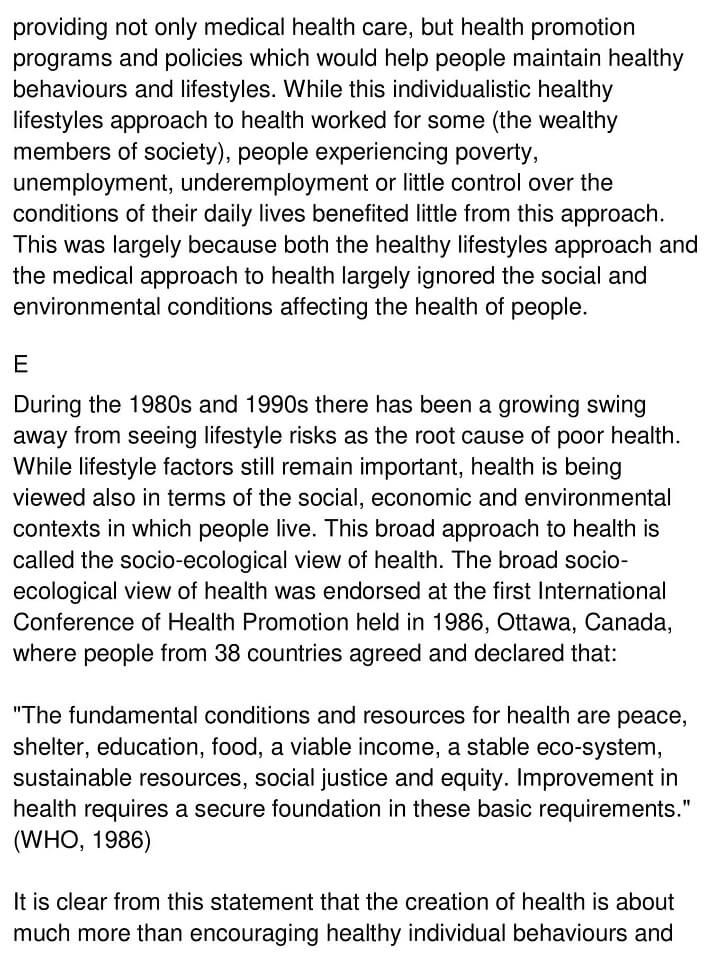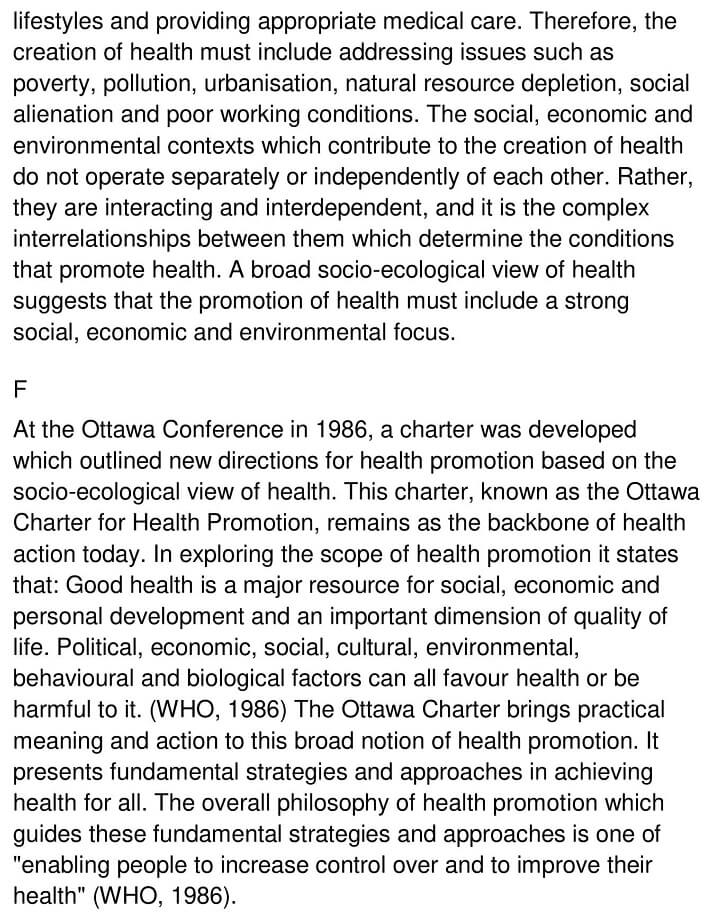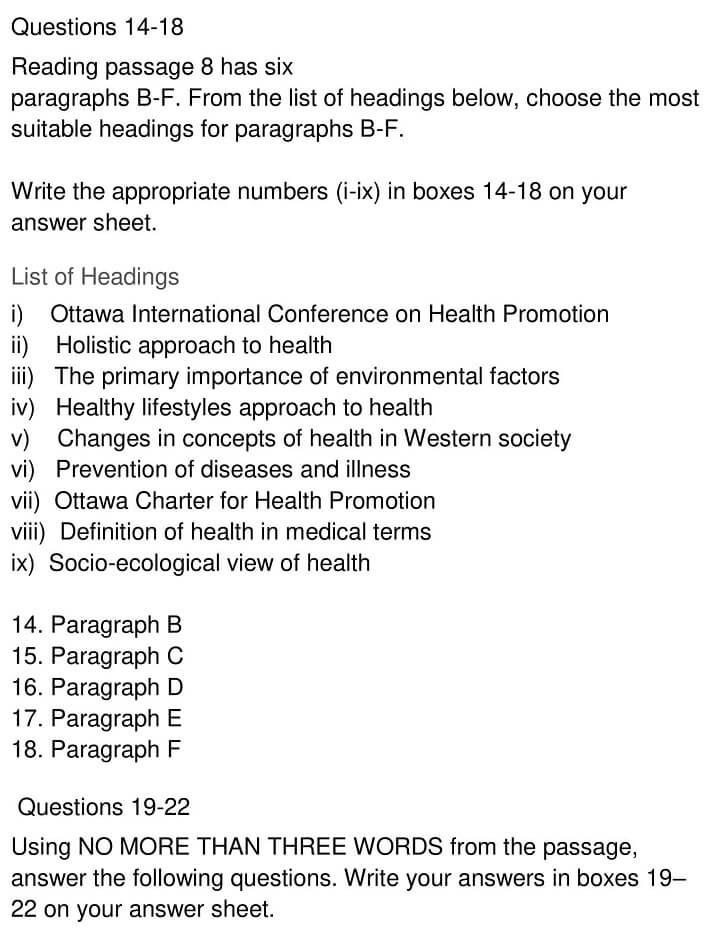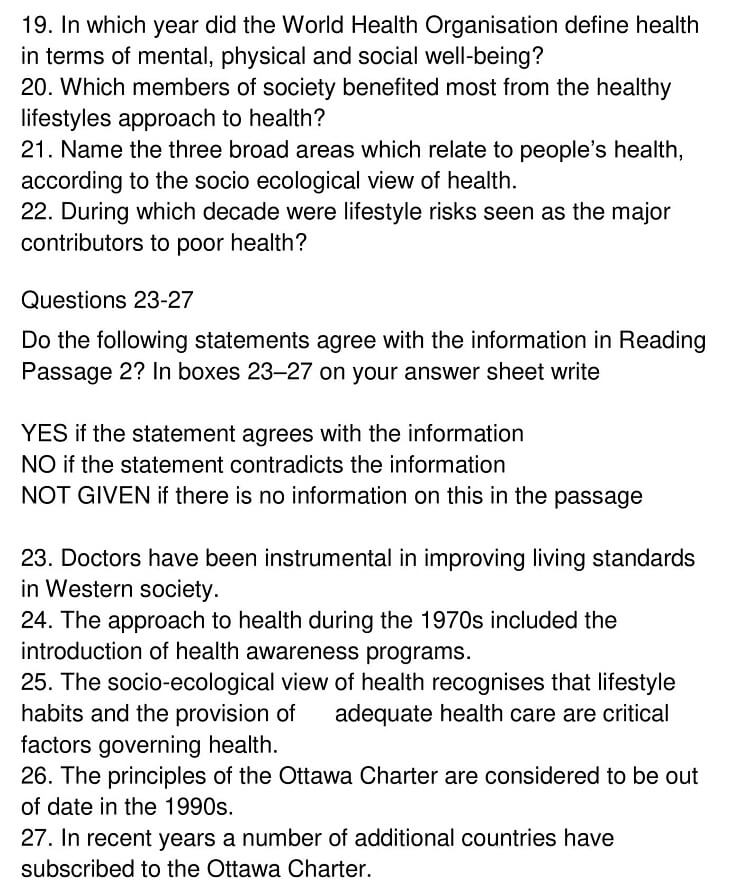Changing Our Understanding of Health Reading Answers
7 min read
Updated On
-
Copy link
Table of Contents

Limited-Time Offer : Access a FREE 10-Day IELTS Study Plan!
The Academic passage ‘Changing our Understanding of Health‘ is a reading passage that appeared in an IELTS Test. Ideally, you should not spend more than 20 minutes on a passage. Let’s see how easy this passage is for you and if you’re able to make it in 20 minutes. If not, try moreIIELTS reading practice test from IELTSMaterial.com.
The question types found in this passage are
Matching Headings
The matching heading type of questions in the IELTS reading test are very common, which requires a test-taker to choose a heading from the list which matches a section or paragraph in the reading passage. The test-taker should understand the theme of each paragraph, identify the difference between the main idea and supporting points, and answer the questions appropriately.
Short Answer Questions
The Short Answer questions are one of the easiest question types in the IELTS reading test, which requires the test-taker to answer questions regarding the information in the reading passage. The test-taker should scan and locate information in the text and understand the paraphrasing of specific words and phrases to answer the questions. Test-takers should not write more than the number of words (answers) as specified in the instructions.
Yes/No/Not Given
The Yes/No/Not Given type of questions are similar to the True/False/Not Given type of questions. This type of question assesses the test-taker’s ability to decide if the information/ fact/ views/ opinion in the question statements are either correct, incorrect, or not given. The test-taker should write Yes, if the information in the statement agrees with the information in the text; write No, if the information in the statement disagrees or contradicts the information in the passage, and write Not Given, if the statement is not mentioned in the reading passage.
Changing Our Understanding of Health





Answers
The answers to the aforementioned questions are given below with their explanations.
14 Answer: viii
Question type: Matching Headings
Answer locations: Paragraph B, line 1 – 2
Answer explanations: We find reference in the 2nd line of paragraph B, which states that good health has been connected to the smooth mechanical operation of the body, whereas ill health has been attributed to a breakdown in this machine. Health in this sense has been defined as the absence of disease or illness and is seen in medical terms. It is evident that paragraph B primarily focuses on the definitions of health in medical terms. Thus, the answer is viii.
15 Answer: ii
Question type: Matching Headings
Answer locations: Paragraph C, line 5
Answer explanations: The fifth line of paragraph C, states that health and the person were seen more holistically (mind/ body/ spirit) and not just in physical terms. We can deduce from these lines that people gave a holistic approach to health. Thus, the answer is ii.
Unlock Answers
16 Answer: iv
Question type: Matching Headings
Answer locations: Paragraph D, line 5
Answer explanations: We understand from fifth line of paragraph D, that creating health meant providing medical healthcare and health promotion programs and policies which would help people maintain healthy behaviors and lifestyles. These lines clearly illustrate the health lifestyle approaches to health. Thus, the answer is iv.
17 Answer: ix
Question type: Matching Headings
Answer locations: Paragraph E
Answer explanations: The introductory line of paragraph E illustrates that during the 1980s and 1990s, there was a growing swing away from seeing lifestyle risks as the root cause of poor health. While lifestyle factors still remain important, health is being viewed in terms of social, economic, and environmental contexts in which people live. This broad approach to health is called the Socio-ecological view of health. Thus, the answer is ix.
18 Answer: vii
Question type: Matching Headings
Answer locations: Paragraph F
Answer explanations: Paragraph F illustrates the development of a charter at the Ottawa conference in 1986, where the charter was developed to outline a new direction of health promotions based on the social-ecological view of health. This charter was known as the Ottawa Charter for Health Promotion. Therefore, it is evident that Paragraph F discusses the Charter for health promotion. So, the answer is vii.
19 Answer: 1946
Question type: Short Answer Questions
Answer locations: Paragraph C, line 3 – 4
Answer explanations: We understand from the 3rd line of paragraph C, that in 1946, the WHO stated that health is a complete state of physical, mental, and social well-being, and is not merely the absence of diseases. These lines indicate that it was in 1946, WHO defined health in terms of mental, physical, and social well-being. Thus, the answer is 1946.
20 Answer: (the) wealthy (members) (of) (society)
Question type: Short Answer Questions
Answer locations: Paragraph D, line 8
Answer explanations: The eighth line in paragraph D states, “While this individualistic healthy lifestyle approach to health worked for some (the wealthy members of society), people experiencing poverty, unemployment, underemployment, or little control over the conditions of their lives benefitted little from this approach.” We can deduce from these lines that the wealthy members of society benefited the most from the healthy lifestyles approach to health. Thus, the answer is (the) wealthy (members) (of) (society).
21 Answer: Social, economic, environmental
Question type: Short Answer Questions
Answer locations: Paragraph E, line 4
Answer explanations: We understand from the fourth line of paragraph E that apart from lifestyle factors which are important, health is viewed in terms of the social, economic, and environmental contexts in which people live. Thus, social, economic, and environmental areas are the three broad areas which relate to people’s health according to the socio-ecological view of health.
22 Answer: (the) 1970s
Question type: Short Answer Questions
Answer locations: Paragraph D, line 1
Answer explanations: The introductory line of paragraph D states that the 1970s was a time of focusing on the prevention of disease and illness by emphasizing the importance of the lifestyle and behaviour of the individual. Specific behaviours which were seen to increase risk of such as smoking, lack of fitness and unhealthy eating habits were targeted. We understand that smoking, lack of fitness and unhealthy eating habits were the lifestyle risks which were seen as major contributors to poor health in the 1970s.
23 Answer: Not Given
Question type: Yes/No/Not Given
Answer locations: Paragraph A & B
Answer explanations: We find reference to Western society in paragraph A & B. However, there is no reference to doctors being instrumental in improving living standards in western society. Thus, the answer is Not Given.
24 Answer: Yes
Question type: Yes/No/Not Given
Answer locations: Paragraph D, line 5
Answer explanations: The fifth line of paragraph D illustrates that creating health meant providing medical health care and health promotion programs and policies which would help people maintain healthy behaviors and lifestyles. These lines are evident that the approach to health during the 1970s included the introduction of health awareness programs. Thus, the answer is Yes.
25 Answer: No
Question type: Yes/No/Not Given
Answer locations: Paragraph E, line 14
Answer explanations: We find reference in 14th line of paragraph E, which states that the creation of health is about much more than encouraging healthy individual behaviours and lifestyles and providing appropriate medical care. We understand that paragraph E illustrates the socio-ecological view of health and these lines indicate that creation of health is much more than simply encouraging healthy individuals behaviors. Thus, the statement contradicts the information in paragraph E. So, the answer is No.
26 Answer: No
Question type: Yes/No/Not Given
Answer locations: Paragraph F, line 3
Answer explanations: Paragraph F mentions the development of a charter known as the Ottawa Charter for Health Promotion, remains as the backbone of health action today. It means that the principles of the charter were still important and were not out of date in the 1990s. So, the answer is No.
27 Answer: Not Given
Question type: Yes/No/Not Given
Answer locations: Paragraph F
Answer explanations: We find reference for Ottawa Charter in Paragraph F, where it is mentioned that the Ottawa Charter for health promotion is still the backbone of health actions. However, it is not mentioned anywhere that several countries have subscribed to the Ottawa Charter.
Check More IELTS Reading Answers
Also check :
Practice IELTS Reading based on question types

Start Preparing for IELTS: Get Your 10-Day Study Plan Today!
Recent Articles

Nehasri Ravishenbagam

Haniya Yashfeen

Haniya Yashfeen

Haniya Yashfeen




Post your Comments
1 Comment